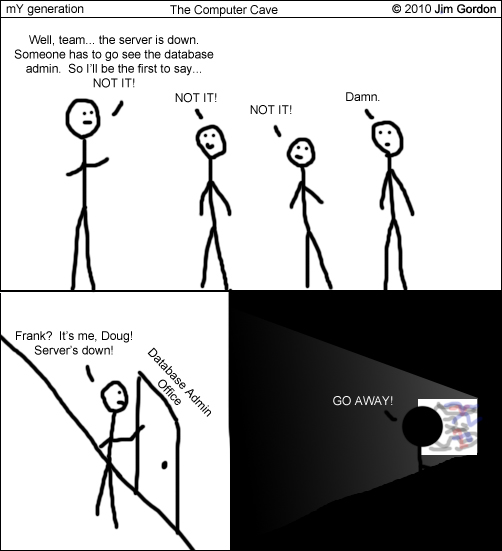|
|
|
Archive for February, 2010
Sunday, February 28th, 2010
See all mY generation posts here.

Posted in Business info, Communication, mY generation | No Comments »
Sunday, February 28th, 2010
 Do you remember Calvin and Hobbs by Bill Watterson? Of all the comics I’ve read over the years that is my all-time favorite. I even own most of the collections in book form. Do you remember Calvin and Hobbs by Bill Watterson? Of all the comics I’ve read over the years that is my all-time favorite. I even own most of the collections in book form.
I did Watterson quotes back in ’08 and I thought that almost leap-day would be a good day to share some from Calvin.
First, you have to understand how Calvin sees himself and, in doing so, you’ll understand a great truth of the modern world. “People think it must be fun to be a super genius, but they don’t realize how hard it is to put up with all the idiots in the world.” Although true, I’ve always reminded myself that for every person I think is an idiot there are at least two others who think I’m one.
It may not be original, but I have always like Calvin’s description of life, “Life is like topography, Hobbes. There are summits of happiness and success, flat stretches of boring routine, and valleys of frustration and failure.” That fits my life, except that the summits were all bunched together, with the last decade one continuous valley; I could do with a few more flats.
Calvin says, “History is the fiction we invent to persuade ourselves that events are knowable and that life has order and direction,” whereas I think that order and direction comes from within.
I’ve always thought that Calvin’s comment, “Careful. We don’t want to learn from this,” would make a great Wall Street motto.
But it is his thoughts on the possibility of other intelligent life in our universe with which I most heartily agree. In fact, I was saying something similar a couple of decades earlier.
“Sometimes I think the surest sign that intelligent life exists elsewhere in the universe is that none of it has tried to contact us.”
Image credit: Just-Us-3 on flickr
Posted in Quotable Quotes | No Comments »
Saturday, February 27th, 2010

‘Leader’ is a word that’s bandied about with reckless abandon, but it is the only word that’s available that carries a fairly universal meaning.
That said, I have several leadership links I think you’ll find interesting.
First, from American Express’ Open Forum, 10 excellent examples of real business leadership. Some refer to companies, others to people, none will take you long to read. And if the story resonates you can always google more in-depth information.
Next is a fascinating analysis from Newsweek that looks at the pros and cons of business executives as politicians. It’s a timely article considering how many are throwing their hats in the ring.
Finally, whether you consider yourself a leader, or just someone who enjoys helping others excel, you’ll find lots of good ideas at LeaderTalk where Becky Robinson has a round up of posts discussing the importance of, and ways to, develop people from some of the smartest coaches around—including me.
Have a great weekend and happy reading.
Image credit: pedroCarvalho on flickr
Posted in Expand Your Mind, Leadership, Politics | 1 Comment »
Friday, February 26th, 2010
 I have a stack of books waiting to be read, some I buy and some are sent by publicists for me to review. I have a stack of books waiting to be read, some I buy and some are sent by publicists for me to review.
Then there is the constantly growing list of books I hear about or see a review and want to read.
But I have only so much reading time and it’s shrinking as we get closer to the launch of our new product (stay tuned).
So I created a new category called Reviews and Recommendations and included MAPping Company Success’ ‘Book Reviews’ and Leadership Turn’s ‘Reading Recommendations’. I hope you find it useful.
Today, I have some interesting recommendations for you.
The first is from Jeffrey Krames, a literary agent who tells the fascinating story of a self-published book that sells for nearly $50 with an unwieldy title that instantly became a top Amazon seller. Whether or not you want to tackle the book you’ll enjoy its story.
Two European authors—Alexander Osterwalder and Yves Pigneur—spent years putting together a stunning book on business models entitled BUSINESS MODEL GENERATION. The two authors had a great deal of help with the design and content of the book, as it was co-authored by 470 Business Model Canvas practitioners from 45 countries… Within 48 hours the book ranked as high as #74 on Amazon, an amazing feat for most any business book and especially this one. Since then, the two versions of the book have occupied two of the top 25 slots on Amazon’s list of bestselling management books every single day.
After reading dozens of day-by-day articles and commentary on the financial meltdown, none of the myriad of books written about it really grabbed me. However, when I read a review of Henry Paulson’s newly published On the Brink: Inside the Race to Stop the Collapse of the Global Financial System in Business Week I was intrigued.
What got my attention (and made me ill) was the following quote.
“All were concerned with excessive risk taking in the markets and appalled by the erosion of underwriting standards,” he writes in his penetrating memoir, On the Brink. Yet they felt forced by competitive pressure to make loans they didn’t like, the former U.S. Treasury Secretary says.
“Isn’t there something you can do to order us not to take all of these risks?” was the gist of a question posed by Chuck Prince, who was still running Citigroup as the bank bumbled toward disaster.
This from some of the most powerful business “leaders” in the country.
Image credit: ginnerobot on flickr
Posted in Business info, Innovation, Reviews & Recommendations, Strategy | No Comments »
Thursday, February 25th, 2010
 Last week I wrote about early-college high school and KIPP—both programs buck the trend exemplified by the Dallas Independent School District in lowering standards. Last week I wrote about early-college high school and KIPP—both programs buck the trend exemplified by the Dallas Independent School District in lowering standards.
Another move towards greater challenge is program that allows kids to graduate high school two years early.
Dozens of public high schools in eight states will introduce a program next year allowing 10th graders who pass a battery of tests to get a diploma two years early… The new system of high school coursework with the accompanying board examinations is modeled largely on systems in high-performing nations including Denmark, England, Finland, France and Singapore. … Students who pass but aspire to attend a selective college may continue with college preparatory courses in their junior and senior years…
The program is organized by the nonprofit National Center on Education and the Economy.
“We’ve looked at schools all over the world, and if you walk into a high school in the countries that use these board exams, you’ll see kids working hard, whether they want to be a carpenter or a brain surgeon.” –Marc S. Tucker, NCEE President
Education reform has often been hung up by teachers unions; that seems to be changing, but the time and cost to fire an incompetent teacher is still disheartening.
Toughening standards, increasing challenge and meaningful rewards work in the adult space, so there is no reason they won’t work in schools.
There seems to be a lot of good stuff going on to provide us with hope for developing thinking, questioning innovative next generation, but, before you get too excited, please join me next Tuesday to see what is happening on the dark side.
Image credit: svilen001on sxc.hu
Posted in Innovation, Leadership's Future | No Comments »
Wednesday, February 24th, 2010

Image credit: Ayla87 on sxc.hu
Posted in Culture, Wordless Wednesday | No Comments »
Tuesday, February 23rd, 2010
 Yesterday we looked at positive and negative aspects of culture and I said that today we would discuss how to change/create a culture or sub-culture. Yesterday we looked at positive and negative aspects of culture and I said that today we would discuss how to change/create a culture or sub-culture.
Repeating yesterday’s warning: if you want a culture that is fundamentally different from the overall company culutre be sure you’re willing to shield your people and take the heat.
Remembering that culture is a function of your MAP (mindset, attitude, philosophy™), here are 7 critical points that you need to think through before starting—whether you are CEO of a startup or a first level supervisor in a large company.
- Know who you are: Since this step is strictly between you and yourself you need to be brutally frank as to your attitudes towards people, motivation, what’s important, what’s OK to do, etc., in other words, know your MAP! You need to know exactly what you think, are comfortable with the elements you embrace and understand that you need to hire people who will flourish in the environment you create.
- Define your cultural goals: Use the knowledge of your MAP to determine the kind of culture you want and write a description including your vision and the specific infrastructure, processes, practices, etc., that are needed to make it reality. Test the attractiveness of your cultural vision by whether you would want to work in a similar culture. If the answer is yes then you can proceed with it; however, if your response is “no way” then you need to rethink what you want because over the long haul there is no way you can sustain a culture in which you don’t believe. Also, people tend to gravitate to people like themselves (likes really do attract). In other words, you will be hired by, work with and hire those with synergistic MAP.
- Know what you have: Honestly assess (warts and all) whatever culture currently exists in your company and department (if you have one or more people you have some kind of culture); without a detailed assessment you won’t know what you need to tweak, change, circumvent, ignore or avoid.
- Be aware of the cost of change: Changing culture often results in turnover and turnover can be costly no matter the condition of the labor market. People join companies because they feel comfortable and change is rarely comfortable. If they don’t like the end result (or the direction it’s heading) they are likely to start looking. If you are aware and prepared that isn’t always a bad thing; cultural changes can’t happen if employees aren’t willing to change their mindset; worse, those who won’t change will make every effort to sabotage the emerging culture. By being prepared you can not only circumvent that, but often turn the saboteur into a new culture evangelist.
- Don’t assume: The human race functions to a great extent on various sets of unconscious assumptions. In the workplace people tend to assume that people with similar educations, experience levels, positions, etc., have similar mindsets, attitudes and philosophies. The next assumption is that based on those similarities everybody would create similar cultures; the third assumption is that the first 2 guarantee people’s willingness to buy into the vision. Predicating acceptance of cultural change on the assumption of deep, unproven commonality is a recipe for disaster.
- Don’t overwhelm the troops: Whether you are changing an entire corporation (Gerstner and IBM), creating a culture for your startup, tweaking it within your department or group, or revamping it in your small business, recognize that you can’t just come in, make an announcement and expect people to buy into the vision. Present it in small bite-size pieces and in such a way that people feel they have input in the process, thus creating a strong feeling of ownership. Better yet, listen to the input and adjust if it makes sense.
- Communicate and sell—don’t order and tell! Even if your goal is a truly collaborative, nurturing culture that challenges and then helps people to realize their full potential you can’t just walk in on Monday and announce that that’s the way it will be from then on.
- First, it’s unlikely that anybody will believe you (talk’s cheap);
- second, if you’re new it’s unlikely they’ll trust you (no track record with them); and
- third, whether you’re proposing a radically different culture or just fine tuning the current one they have no reason to get on the bandwagon if it means changing.
In the final analysis what you do will carry far more weight than anything you say about your culture.
It boils down to your having the courage to walk your talk.
Image credit: Svadilfari on flickr
Posted in Business info, Change, Communication, Culture | No Comments »
Monday, February 22nd, 2010
 Corporate culture is a big deal these days, often seen as the difference between success and failure. Corporate culture is a big deal these days, often seen as the difference between success and failure.
Millions of words have been used by thousands of people to describe and explain culture, but it pretty much boils down to the following:
- How the people relate to each other professionally and personally; their personalities and interpersonal communications.
- The work environment/atmosphere/ethics/morale/people/style/etc.
- The company’s identity.
- Environment of interaction and judgment.
- The primary reason people join/leave the company/manager.
- The way things really are as opposed to how they’re described (the walk vs. the talk).
Money lures, but culture holds. Culture is why people join a company—and more importantly, why they stay. It is what motivates (or demotivates) them, and cultural changes are frequently why they leave. Additionally, people learn from experience and eventually will reflect the traits of the cultures in which they work; as with other relationships, people will continue to gravitate to the same situation they were in previously.
Cultural elements people want:
- The opportunity to truly “make a difference.”
- To be treated fairly.
- Positive ethics and values.
- To trust management and be trusted by them.
- To embrace the idea that work can and should be fun.
- Accurate prioritizing of company, team and individual goals while keeping them synergistic
- A positive “can-do” attitude (aggressive, but realistic).
- A conscious effort to stamp out “not invented here” syndrome (in all its varied forms), so as to not waste time reinventing the wheel.
- Continuing development and quality improvement in people, product/services and processes.
- Committing to employees, customers, and investors—and meeting those commitments.
- An open, accurate, company-wide flow of information starting from the top.
- An environment that encourages people to reach their full potential, professionally and personally.
What people don’t want:
- Politics: personal, group, or senior management
- Unfairness; favoritism; star mentality
- Unnecessary bureaucracy; inflexible process or bureaucracy masquerading as process
- Poor management practices such as: erratic management; micro-management; workaholism; intimidation; belittling or contemptuous treatment; no loyalty; poor scheduling; the attitude that “we don’t have the time to do it right but we have the time to do it over”
- Any form of harassment whether overt or covert
- A generally negative attitude, i.e., the glass is half empty
- Arrogance or an elitist attitude
- An unwillingness (at whatever level) to seek and implement the compromises necessary to meet organizational needs within the required timeframe
Obviously there are many more philosophies, attitudes, and actions that I could list, but most would fit the spirit, if not the specifics of the two lists.
In general culture comes from, or is enabled by, the top and rarely can be changed from below.
That said, every person in a management role from team leader up creates a subculture in their own organization.
If you are strong enough and believe deeply enough, you can become an umbrella to your organization and shield it from the toxic elements in the overall culture.
But don’t kid yourself; this is a difficult path to choose, so it is wise to make the choice consciously, instead of accidentally bucking your company’s culture.
Join me tomorrow when we look at how to create a culture—or sub-culture.
Image credit: HikingArtist on flickr
Posted in Business info, Culture, Motivation, Retention | 1 Comment »
Sunday, February 21st, 2010
See all mY generation posts here.

Posted in mY generation | No Comments »
Sunday, February 21st, 2010
 I love George Bernard Shaw; he was brilliant and had a rapier wit with which he skewered deserving people, ideas and situations, while supplying pithy commentary on the events of his time as well as inspirational ideas. I love George Bernard Shaw; he was brilliant and had a rapier wit with which he skewered deserving people, ideas and situations, while supplying pithy commentary on the events of his time as well as inspirational ideas.
Some of the things he said have passed into such common usage that few people even realize they are quotes. How many times have you seen this on cards, plaques and samplers?
“You see things; and you say, ‘Why?’ But I dream things that never were; and I say, ‘Why not?’”
Sound familiar? It’s a favorite of mine; in fact, I have it on my office wall.
So I went looking for a few of the more esoteric Shawisms.
The first is an important heads-up for all of us, but especially anyone in a leadership role; you might even find that it accurately describes the problems you’re having.
“The single biggest problem in communication is the illusion that it has taken place.”
Progress is something that both people and business expend great effort to do; what we often forget is that progress means things will be different.
“Progress is impossible without change, and those who cannot change their minds cannot change anything.”
Because we progress we are all constantly changing, but too often people don’t take the time to find out who you are now; Shaw sums the problem and solution up in just a few words.
“The only man who behaves sensibly is my tailor; he takes my measurements anew every time he sees me, while all the rest go on with their old measurements and expect me to fit them”
Collaboration boosts progress; Shaw understood this and explained why it’s so important.
“If you have an apple and I have an apple and we exchange these apples then you and I will still each have one apple. But if you have an idea and I have an idea and we exchange these ideas, then each of us will have two ideas.”
Progress requires innovation, but real progress requires thinking as opposed to rephrasing previous ideas to sound new, but if Shaw was correct it accounts for the lack of progress in so many areas.
“Two percent of the people think; three percent of the people think they think; and ninety-five percent of the people would rather die than think.”
Those who don’t think often lean on ideology to support their agenda. The problem with ideology is that it doesn’t lend itself to seeing another’s world-view. Shaw understood how ridiculous this was.
“The frontier between hell and heaven is only the difference between two ways of looking at things.”
My last choice is one I would like to apply to all politicians and educators. Perhaps, if we did, it would significantly improve the quality of those who claim to serve. (Hmm, it probably wouldn’t hurt to apply it to everybody else, too, including yours truly.)
“We should all be obliged to appear before a board every five years and justify our existence…on pain of liquidation.”
Image credit: Wikimedia Commons
Posted in Change, Communication, Quotable Quotes | No Comments »
|
 Subscribe to
Subscribe to
MAPping Company Success
About Miki 
Clarify your exec summary, website, etc.
Have a quick question or just want to chat? Feel free to write or call me at 360.335.8054
The 12 Ingredients of a Fillable Req
CheatSheet for InterviewERS
CheatSheet for InterviewEEs™
Give your mind a rest. Here are 4 quick ways to get rid of kinks, break a logjam or juice your creativity!
Creative mousing
Bubblewrap!
Animal innovation
Brain teaser
The latest disaster is here at home; donate to the East Coast recovery efforts now!
Text REDCROSS to 90999 to make a $10 donation or call 00.733.2767. $10 really really does make a difference and you'll never miss it.
And always donate what you can whenever you can
The following accept cash and in-kind donations: Doctors Without Borders, UNICEF, Red Cross, World Food Program, Save the Children
*/
?>About Miki
About KG
Clarify your exec summary, website, marketing collateral, etc.
Have a question or just want to chat @ no cost? Feel free to write
Download useful assistance now.
Entrepreneurs face difficulties that are hard for most people to imagine, let alone understand. You can find anonymous help and connections that do understand at 7 cups of tea.
Crises never end.
$10 really does make a difference and you’ll never miss it,
while $10 a month has exponential power.
Always donate what you can whenever you can.
The following accept cash and in-kind donations:
|

